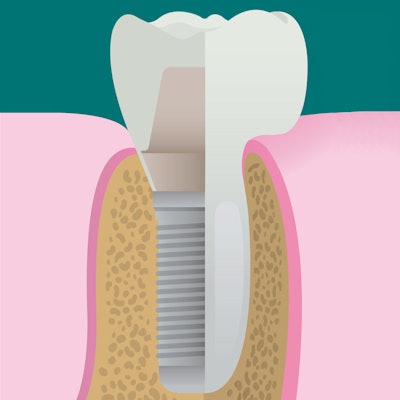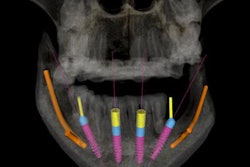
Researchers from India ran simulations using CAD software to test implant stress distribution in a study published on February 10 in Materials Today: Proceedings. They found that an ideal implant abutment design would likely be shorter and more angled than conventional designs.
The authors tested three different implant abutment designs to simulate maximum stress load in reaction to different forces. To run their tests, they leveraged CAD software, allowing them to model how small changes could result in better stress bearing.
"Implant can be designed and studied in computer environment before it is implemented to the patient," wrote the authors, led by N. Jayakumar, an assistant professor from the Bannari Amman Institute of Technology in Sathyamangalam. "This will save time for the design and prevent any permanent damage caused by miss-implementation of implant."
Implants come in a variety of shapes, diameters, materials, floor topographies, and thread styles. The type of implant and abutment structure is an essential component of its overall performance, the authors noted.
For their study, Jayakumar and colleagues created three CAD models of dental implants and abutments:
- Standard implant model -- measured 17.87 mm in height and 2.27 mm in diameter
- Reduced height implant model -- 2 mm shorter than the standard model
- Angled implant model -- 2 mm shorter than the standard implant; abutment angle changed by 10°
The authors designed all three implant and abutment models using SolidWorks 2018 (Dassault Systèmes) software. They then converted the software's file format to analyze stress distribution with the Ansys 19.2 (Ansys) simulation software.
| Simulated maximum stress load (MPa) for 3 implant designs | |||
| Standard implant model | Height-reduced implant model | Angled implant model | |
| 36 N vertical load | 16.9 | 14.5 | 11.6 |
| 36 N 30° angular load | 49.2 | 38.3 | 33.6 |
| 100 N vertical load | 47.0 | 40.3 | 32.1 |
| 100 N 30° angular load | 136.7 | 106.5 | 93.2 |
The standard implant model had the highest stress load under all conditions studied by the authors. Reducing the implant height by just 2 mm improved the maximum stress load in all scenarios, and angling the implement abutment further improved the results.
"In existing implant, the stress is 47.076 MPa with 100 N vertical load is applied and after reducing the height 2 mm stress has been minimized to 40.277 MPa at the same loading criteria," the authors wrote. Changing the angle reduced the stress when compared with both the standard implant and height-reduction models, they added.
The authors noted their CAD testing method could work well for cobalt-chromium (Co-Cr) surgical templates. Co-Cr material can allow for a thinner surgical template and, as a result, better access to the interarch operative space, they wrote. They also pointed out that the material is frequently used in stents and other surgical implants.
However, the CAD approach also has its limitations. The authors cautioned that a clinician would need a computer to create the template and that Co-Cr is more expensive than other materials.
"This study helps to choose the appropriate type of abutment for the maximum load conditions with minimal stress when compared with the existing abutment shapes. ... The best abutment is type 3 implant abutment for implementing on patients in dental implantation," they wrote.



















